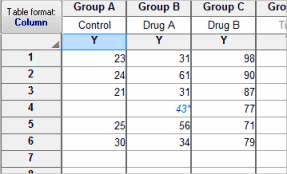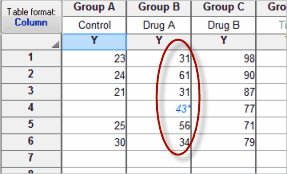In a column data table, each column defines a group. These groups are defined by one scheme, perhaps "control vs. treated." You can have more than two groups in a one-way table, for example "placebo vs. low-dose vs. high-dose.
Analyses performed with Column data
•t test (one-sample, paired and unpaired)
•Mann-Whitney
•Wilcoxon
•Column statistics (including normality tests)
•One-way ANOVA (followed by Tukey, Dunnett, Newman-Keuls or Bonferroni post tests)
•Kruskal-Wallis
•Friedman
•Bland-Altman
•ROC curves
Example of a column table

•
•Each column defines a treatment group.
•Prism does not use a separate column to enter the grouping variable. Instead the groups are defined by columns.
•If data are not matched or paired, rows have no special meaning. Enter data in any order you like.
•If data are from a before-after experiment with clear pairing or matching, place each set of matched results on one row. Optionally, use the row title to label it.
•Blue italics values are “excluded” (ignored by analyses and graphs). Use Exclude Values.
Error bars
For one-way tables, Prism will calculate error values and create error bars automatically. Enter all the values for a data set in a single column.
